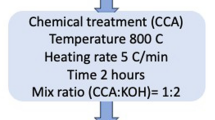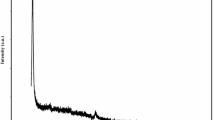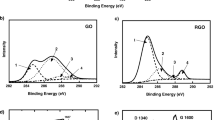Abstract
Xanthate has become the main organic pollutant in mine wastewater because of its widespread use as a flotation collector. Multilayer graphene oxide (MGO) exhibits excellent adsorption performance in removing organic contaminants from aqueous solutions that is attributed to its rich oxygen-containing functional groups and large specific surface area. MGO was prepared using the modified Hummers method. Moreover, MGO was characterised by Raman spectroscopy, X-ray diffraction, and X-ray photoelectron spectroscopy (XPS). The adsorption of xanthate by MGO follows the Langmuir model, and thermodynamic studies have shown that the adsorption process can be completed spontaneously. The results of XPS analysis indicated that the oxygen content on the MGO surface decreased after the adsorption of xanthate, and the proportion of oxygen-containing functional groups was also significantly lower than that before adsorption. Molecular dynamics studies revealed that the head group of xanthates was closer to the surface of the MGO than the tail group. This research indicates that MGO can be successfully used to adsorb xanthate. In addition, the dispersion force between the head group of xanthates and the oxygen-containing functional group on the MGO surface was the dominant factor affecting the adsorption process.
Graphical abstract
Multilayer graphene oxide can be used to remove xanthate in aqueous solutions, and the oxygen-containing groups on multilayer graphene oxide can provide adsorption sites for xanthate.










Similar content being viewed by others
References
Hope GA, Watling K, Woods R (2001) A SERS spectroelectrochemical investigation of the interaction of isopropyl, isobutyl and isoamyl xanthates with silver. Colloids and Surfaces A: Physicochem Eng Aspects 178(1–3):157–66.
Liu W, Liu W, Wang B, Duan H, Zhao Q (2019) Novel hydroxy polyamine surfactant N-(2-hydroxyethyl)-N-dodecyl-ethanediamine: its synthesis and flotation performance study to quartz. Min Eng 142:105894.
Molina GC, Cayo CH, Rodrigues MANS, Bernardes AM (2013) Sodium isopropyl xanthate degradation by advanced oxidation processes. Minerals Eng 45:88–93.
Fu P, Feng J, Yang T, Yang H (2015) Comparison of alkyl xanthates degradation in aqueous solution by the O3 and UV/O3 processes: efficiency, mineralization and ozone utilization. Minerals Engineering. 81:128–34
Cheng W, Zhang Q, Wen-Qiang MA (2010) A research on removal of xanthate from floatation wastewater with activated carbon. Acta Mineralogica Sinica 30(2):262–7
Liu R, Sun W, Ouyang K, Zhang L, Hu Y (2015) Decomposition of sodium butyl xanthate (SBX) in aqueous solution by means of OCF: ozonator combined with flotator. Minerals Eng 70:222–7.
Chockalingam E, Subramanian S, Natarajan KA (2003) Studies on biodegradation of organic flotation collectors using Bacillus polymyxa. Hydrometallurgy 71(1–2):249–56
Chen S, Gong W, Mei G, Zhou Q, Bai C, Xu N (2011) Primary biodegradation of sulfide mineral flotation collectors. Minerals Engineering 24(8):953–5
Rezaei R, Massinaei M, Zeraatkar Moghaddam A (2018) Removal of the residual xanthate from flotation plant tailings using modified bentonite. Minerals Eng 119:1–10.
Amrollahi A, Massinaei M, Moghaddam AZ (2019) Removal of the residual xanthate from flotation plant tailings using bentonite modified by magnetic nano-particles. Minerals Eng 134(142–55):11.
Lerf A, He H, Forster M, Klinowski J (1998) Structure of graphite oxide revisited. The Journal of Physical Chemistry B. 102(23):4477–82
Dreyer DR, Park S, Bielawski CW, Ruoff RS (2009) The chemistry of graphene oxide. Chem Soc Rev 39(1):228–40.
Fallah S, Mamaghani HR, Yegani R, Hajinajaf N, Pourabbas B (2020) Use of graphene substrates for wastewater treatment of textile industries. Adv Compos Hybrid Mater 3(3):1–7.
Kommu A, Velachi V, Cordeiro MNDS, Singh JK (2017) Removal of Pb(II) Ion using PAMAM dendrimer grafted graphene and graphene oxide surfaces: a molecular dynamics study. J Phys Chem A. 121(48):9320–9.
Chandra V, Kim KS (2011) Highly selective adsorption of Hg2+ by a polypyrrole-reduced graphene oxide composite. Chem Commun 47(13):3942–4.
Mi X, Huang G, Xie W, Wang W, Liu Y, Gao J (2012) Preparation of graphene oxide aerogel and its adsorption for Cu2+ ions. Carbon. 50(13):4856–64
Xu J, Wang L, Zhu Y (2012) Decontamination of bisphenol A from aqueous solution by graphene adsorption. Langmuir 28(22):8418–25.
Xu J, Zhu Y-F (2013) Elimination of bisphenol A from water via graphene oxide adsorption. Acta Physico-Chimica Sinica 29(04):829–36.
Zhang Y, Cheng Y, Chen N, Zhou Y, Li B, Gu W, Shi X, Xian Y (2014) Recyclable removal of bisphenol A from aqueous solution by reduced graphene oxide–magnetic nanoparticles: adsorption and desorption. J Colloid Interface Sci 421:85–92.
Liu W, Liu W, Wang B, Zhao Q, Chen X (2019) Molecular-level insights into the adsorption of a hydroxy-containing tertiary amine collector on the surface of magnesite ore. Powder Tech 355:700–7.
You X, He M, Cao X, Wang P, Wang J, Li L (2019) Molecular dynamics simulations of removal of nonylphenol pollutants by graphene oxide: experimental study and modelling. Appl Surf Sci 475:621–6.
Singh M, Bajaj NK, Bhardwaj A, Singh P, Kumar P, Sharma J (2018) Study of photocatalytic and antibacterial activities of graphene oxide nanosheets. Adv Compos Hybrid Mater 1(4):759–65.
Singh N, Jana S, Singh GP, Dey RK (2020) Graphene-supported TiO2: study of promotion of charge carrier in photocatalytic water splitting and methylene blue dye degradation. Adv Compos Hybrid Mater 3(1):127–40.
Zhang W, Shi X, Zhang Y, Gu W, Li B, Xian Y (2013) Synthesis of water-soluble magnetic graphene nanocomposites for recyclable removal of heavy metal ions. J Mater Chem A. 1(5):1745–53
Liu Q, Yang C, Lyu X, Chen P, You X, Li L, Wang J (2021) Evolution of ettringite content and its effects on hydration properties of CaO/fluorgypsum-activated granulated blast furnace slag binders. Adv Comp Hybrid Matl.
Zhang X, Ziemer KS, Weeks BL (2019) Combustion synthesis of N-doped three-dimensional graphene networks using graphene oxide–nitrocellulose composites. Adv Compos Hybrid Mater 2(3):492–500.
Liu S, Chen M, Cao X, Li G, Zhang D, Li M, Meng N, Yin J, Yan B (2020) Chromium (VI) removal from water using cetylpyridinium chloride (CPC)-modified montmorillonite. Sep Purifi Tech 241:116732.
Zhang W, He M, Wei H, Zhu X, You X, Lyu X, Li L (2018) Molecular dynamics simulations of interaction between sub-bituminous coal and water. Mol Simul 44(9):769–73
Plimpton S (1995) Fast parallel algorithms for short-range molecular dynamics. J Comput Phys 117(1):1–19.
Sun HJ (1998) COMPASS: an ab initio force-field optimized for condensed-phase applications – overview with details on alkane and benzene compounds. J Phys Chem B 102:7338–64.
Gao Y, Li Y, Zhang L, Huang H, Hu J, Shah SM, Su X (2012) Adsorption and removal of tetracycline antibiotics from aqueous solution by graphene oxide. J Colloid Interface Sci 368(1):540–6
Xiang X, Pan F, Li Y (2017) A review on adsorption-enhanced photoreduction of carbon dioxide by nanocomposite materials. Adv Compos Hybrid Mate 1(1):6–31.
He M, Zhang W, Cao X, You X, Li L (2018) Adsorption behavior of surfactant on lignite surface: a comparative experimental and molecular dynamics simulation study. Int J Mol Sci 19(2):437.
Yu G, Lu Y, Guo J, Patel M, Bafana A, Wang X, Qiu B, Jeffryes C, Wei S, Guo Z (2018) Carbon nanotubes, graphene, and their derivatives for heavy metal removal. Adv Compos Hybrid Mater 1:56–78.
Lyu X, You X, He M, Zhang W, Wei H, Li L, He Q (2018) Adsorption and molecular dynamics simulations of nonionic surfactant on the low rank coal surface. Fuel. 211:529–34
Gang Z, Cuicui X, Weimin C, Qi Z, Wen N (2015) Effects of oxygen element and oxygen-containing functional groups on surface wettability of coal dust with various metamorphic degrees based on XPS experiment. J Anal Method Chem 2015:467242.
You X, He M, Zhu X, Wei H, Cao X, Wang P, Li L (2019) Influence of surfactant for improving dewatering of brown coal: a comparative experimental and MD simulation study. Sep Purifi Tech 210:473–8.
Tao C, Feng H, Zhou J, Lu L, Lu X (2009) Molecular simulation of oxygen adsorption and diffusion in polypropylene. Acta Physico-Chimica Sinica. 25(7):1373–8
You X, He M, Zhang W, Wei H, Lyu X, He Q, Li L (2018) Molecular dynamics simulations of nonylphenol ethoxylate on the Hatcher model of subbituminous coal surface. Powder Tech 332:323–30
Zhang Y, Zhu H, Zhu J, Yang F, He H, Qin Z, Shi Q, Pan G (2021) Experimental and emulational study on the role of ion in coal adsorbing kerosene: Water-kerosene interface and catenoid characteristics. Fuel. 294: 120540.
Funding
This work was supported by the National Natural Science Foundation of China (Nos. 51904174, 52074175), Natural Science Foundation of Shandong Province (No. ZR2019BEE075), Young Science and Technology Innovation Program of Shandong Province (No. 2020KJD001), Key Research and Development Project of Shandong (No. 2019GGX103035), Scientific Research Foundation of Shandong University of Science and Technology for Recruited Talents (No. 2019RCJJ007), and Youth Science and Technology Talent Growth Program of Guizhou Province (No. KY[2018]466).
Author information
Authors and Affiliations
Corresponding author
Ethics declarations
Conflict of interest
The authors declare no competing interests.
Additional information
Publisher's Note
Springer Nature remains neutral with regard to jurisdictional claims in published maps and institutional affiliations.
Rights and permissions
About this article
Cite this article
Li, L., He, M., Feng, Y. et al. Adsorption of xanthate from aqueous solution by multilayer graphene oxide: an experimental and molecular dynamics simulation study. Adv Compos Hybrid Mater 4, 725–732 (2021). https://doi.org/10.1007/s42114-021-00310-4
Received:
Revised:
Accepted:
Published:
Issue Date:
DOI: https://doi.org/10.1007/s42114-021-00310-4




